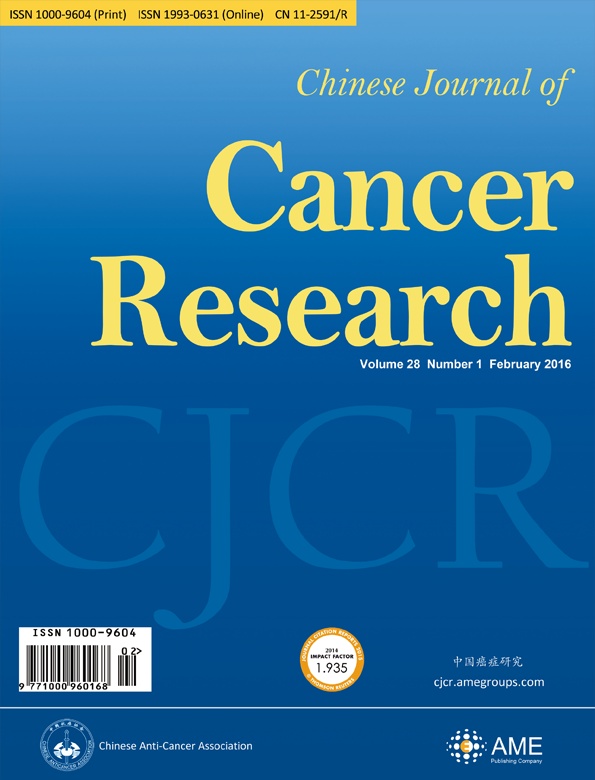基于18FDG PET/ ct的体积参数是局部晚期胃癌患者总生存期的预测指标
IF 7
2区 医学
Q1 ONCOLOGY
引用次数: 1
摘要
目的探讨术前氟脱氧葡萄糖(FDG)正电子发射断层扫描/计算机断层扫描(PET/CT)对局部晚期胃癌(LAGC)患者预后的价值。方法144例LAGC患者[中位年龄63岁(范围48 ~ 80岁)]在接受任何治疗前接受了18f - fdg PET/CT检查。在PET/CT上测量原发病变的最大标准化摄取值(SUVmax)、平均标准化摄取值(SUVmean)、代谢肿瘤体积(MTV)和病变总糖酵解(TLG),并将其与临床病理特征和生存期进行相关性分析。结果两组患者的SUVmean、SUVmax、MTV、TLG在Lauren分型、组织学分级及T分型上差异均有统计学意义(P<0.05)。在26.5个月的随访期间,51例(35.4%)患者死亡,70例(48.6%)患者出现疾病进展。MTV和TLG的最佳阈值分别为15.1 cm3和47.3 cm3。TLG值高的患者3年无进展生存期(PFS)和总生存期(OS)分别为30%和38%,TLG值低的患者为38%和47% (P<0.05)。单因素和多因素分析表明,淋巴结转移和T分期是PFS的独立预后因素;T分期、组织学分级、TLG是影响OS预后的独立因素(P<0.05)。分子标记与患者预后无关系。结论18F-FDG PET/CT显示原发性胃肿瘤代谢活性是胃癌患者预后的一个因素。本文章由计算机程序翻译,如有差异,请以英文原文为准。
A 18FDG PET/CT-based volume parameter is a predictor of overall survival in patients with local advanced gastric cancer
Objective The present study investigated the prognosis value of preoperative fluorodeoxyglucose (FDG) positron emission tomography/computed tomography (PET/CT) in patients with local advanced gastric cancer (LAGC). Methods In total, 144 patients [median age 63 (range: 48−80) years old] with LAGC underwent18F-FDG PET/CT prior to any treatment. The maximum standardized uptake values (SUVmax), mean standardized uptake values (SUVmean), metabolic tumor volume (MTV) and total lesion glycolysis (TLG) of the primary lesion were measured on PET/CT and correlated with clinicopathological features and survival. Results Significant differences in SUVmean, SUVmax, MTV and TLG were found according to Lauren’s classification, histologic grade and T category (P<0.05). During the 26.5-month follow-up, 51 (35.4%) patients died and 70 (48.6%) exhibited disease progression. The optimal thresholds of MTV and TLG were 15.1 cm3 and 47.3 cm3, respectively. The 3-year progression-free survival (PFS) and overall survival (OS) for patients with high TLG values were 30% and 38% compared to 38% and 47% for low TLG values, respectively (P<0.05). Univariate and multifactor analyses demonstrated that lymph node metastasis and T stage were independent prognostic factors for PFS; T stage, histologic grade and TLG were independent prognostic factors for OS (P<0.05). Molecular markers had no relationship with patient’s outcomes. Conclusions Metabolic activity of primary gastric tumors from 18F-FDG PET/CT is a prognostic factor in patients with LAGC.
求助全文
通过发布文献求助,成功后即可免费获取论文全文。
去求助
来源期刊
自引率
9.80%
发文量
1726
审稿时长
4.5 months
期刊介绍:
Chinese Journal of Cancer Research (CJCR; Print ISSN: 1000-9604; Online ISSN:1993-0631) is published by AME Publishing Company in association with Chinese Anti-Cancer Association.It was launched in March 1995 as a quarterly publication and is now published bi-monthly since February 2013.
CJCR is published bi-monthly in English, and is an international journal devoted to the life sciences and medical sciences. It publishes peer-reviewed original articles of basic investigations and clinical observations, reviews and brief communications providing a forum for the recent experimental and clinical advances in cancer research. This journal is indexed in Science Citation Index Expanded (SCIE), PubMed/PubMed Central (PMC), Scopus, SciSearch, Chemistry Abstracts (CA), the Excerpta Medica/EMBASE, Chinainfo, CNKI, CSCI, etc.

 求助内容:
求助内容: 应助结果提醒方式:
应助结果提醒方式:


